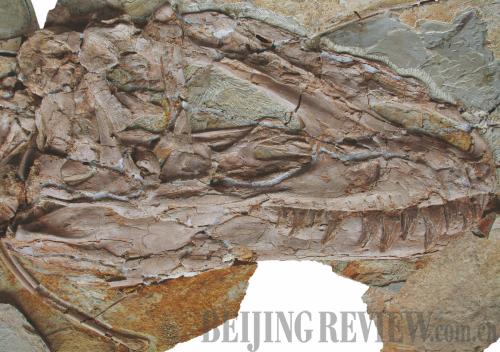|
 |
|
NEW FINDING: A fossil of the skull of Yutyrannus huali is found in west Liaoning Province (ZANG HAILONG) |
About 125 million years ago, when Yutyrannus lived, the climate in some areas of the Earth might have turned cold. Scientists estimated that the west Liaoning Province in that ancient time might be as cold as it is now. Yutyrannus living in that period might have had to grow feathers to maintain its body temperature.
The newly discovered specimens of Yutyrannus push the feathered dinosaurs to a broader range. "Yutyrannus dramatically increases the size range of dinosaurs for which we have definite evidence of feathers," Xu said.
The finding could also give more clues about climate change. In most people's view, dinosaurs had smooth skin. But creatures have inherent abilities to adapt themselves to environmental changes. Dinosaurs are not an exception. Throughout the Mesozoic Era, the Earth underwent drastic changes of climate and geological environment. The filaments of Yutyrannus can be regarded as an indication for the cold climate of the period when they lived.
The feathered Yutyrannus is also useful to understand the mysterious link between dinosaurs and birds. Based on the discovery of Archaeopteryx, which lived about 150 million years ago, in south Germany in 1862, scientists guessed that there must be close links between dinosaurs and birds because they have so many similar biological features, such as feathers. Birds might have evolved from dinosaurs, and Archaeopteryx might be the middle link, many scientists speculated. But the argument was controversial because there had not been much evidence to prove the hypothesis.
Thanks to a large volcanic ash layer left from 145 million to 125 million years ago in west Liaoning, fossils of various animals and plants of that period were well preserved. In 1996, Ji Qiang, a Chinese paleontologist, published a paper about the discovery of Sinosauropteryx, a kind of feathered Compsognathus, providing more evidence for the evolution of birds from dinosaurs. From then on, Chinese scientists have been making important discoveries of feathered dinosaurs in west Liaoning. By observing the composition and structures, scientists found the feathers from the two creatures, birds and dinosaurs, are very similar.
Today, most paleontologists have accepted the hypothesis that birds originated from dinosaurs. But the new findings call into question the status of Archaeopteryx as the ancestor of birds.
Last year, Xu published a paper in Nature, pointing out that Archaeopteryx was a kind of Deinonychus rather than primitive bird. The argument was based on the analysis on the phylogeny of Deinonychus and early birds.
"We unearthed the fossil of a small Deinonychus in west Liaoning, which had a very close genetic relationship with Archaeopteryx," Xu said. "Deinonychus once lived widely on the continents of Asia, America and Africa. They went extinct in the late Cretaceous."
Email us at: baishi@bjreview.com | 